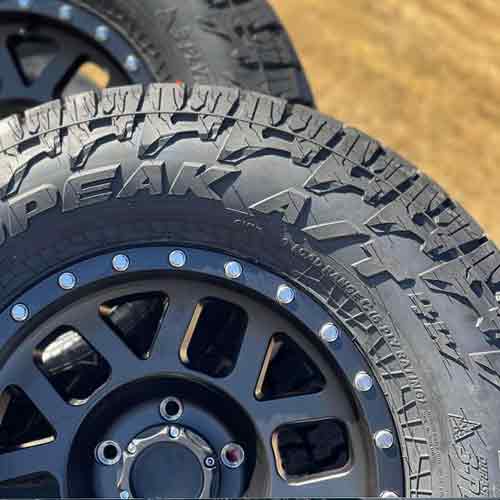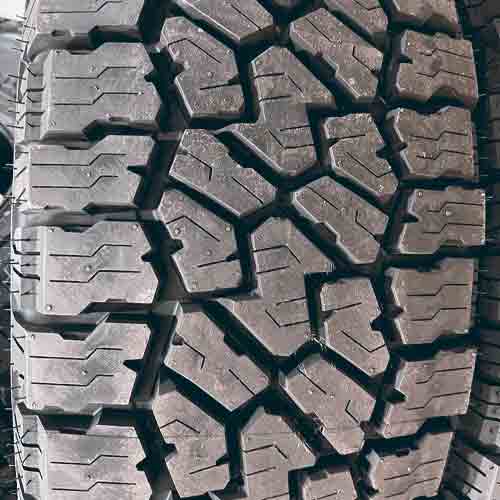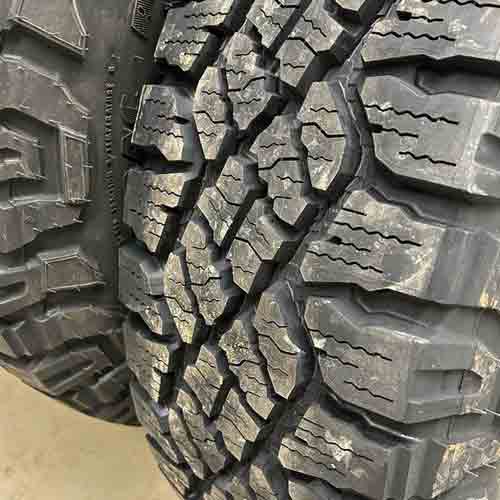Introducing the Falken Wildpeak AT4w, the latest advancement in the all-terrain tire lineup, building on the success of the AT3w. Meanwhile, the Goodyear RT, evolving from the renowned Wrangler DuraTrac, enters as a hybrid rugged terrain tire, skillfully merging characteristics of both all-terrain and mud-terrain tires.

Let’s explore which of these might be the best fit for your needs.
Looking at Sizes First
The new Goodyear Wrangler DuraTrac RT comes in 42 sizes, from 16 to 20 inches rims. These sizes have following specifications.
- Speed ratings: R, S, T and Q.
- Load ratings: SL, XL, E and F.
- Weight: 42 to 85 lbs.
- Tread depth: 16 – 18/32″.
- UTQG: 500 B B.
- Treadwear warranty: 50k miles on all sizes.
On the other side, the new Falken Wildpeak AT4w comes in 15 to 22 inches wheels, with following specs.
- Speed ratings: T, R, and S only.
- Load Range: SL, XL, C to F.
- Tread depth: 13 to 19.7/32″.
- Weight Range: 35.1 to 80 lbs.
- UTQG: 660 A B (on most, and 660 B B on a few sizes).
- Warranty: 60k for LT, and 65k for P metric sizes.
- All sizes have 3PMSF ratings only with M+S.
Dry Performance Evaluation
To effectively evaluate dry performance, my analysis concentrates on two critical aspects: handling and directional grip of the tire.
Let’s start with later.
Directional Grip and Stability
Directional grip primarily measures a tire’s braking efficiency, which is largely influenced by its contact patch, which is the tire’s footprint on the road.
Stability, on the other hand, is determined by the tread’s flexibility (which is its ability to return to its original shape quickly after making turns or compressing against the road surface during maneuvers).
Now, among the tires evaluated, the Falken Wildpeak AT4w stands out in both categories. And its superior performance is attributed to the denser arrangement of its central lugs, which significantly enhances traction.

Wildpeak AT4w
Furthermore, the Falken tire’s (relatively) lighter construction contributes to its efficiency, maintaining lower momentum and thus requiring less force to come to a stop.
Conversely, the Duratrac RT, while not underperforming, does exhibit some limitations in these areas. In braking tests, such as the averaged 60 to 0 mph, it falls short by a small margin (less than half a foot). This discrepancy can primarily be attributed to its more aggressive tread design and heavier build.
Lateral Grip and Handling
The effectiveness of tire handling, particularly in dry cornering, depends significantly on the performance of the tire’s shoulders and sidewalls.
These components bear the most (weight) pressure during turns, making substantial contact with the road and influencing two key performance metrics: lateral grip and steering response.
Let’s start with lateral grip first.
Lateral Grip and Mid-Cornering Performance
Lateral grip is evaluated by the lateral g-forces a tire generates at the apex of a turn, also known as mid-cornering grip.
And in this regard, the Falken WildPeak AT4W consistently outperforms its counterpart. Its shoulder lugs not only offer a greater surface area for road contact but also feature a robust design with numerous biting edges, enhancing the g-forces produced during cornering.
Additionally, the tire includes more biting notches and a dry-road-oriented siping pattern, allowing for superior traction.
Steering Feedback and Handling
Steering feedback relates to how responsive the tires are to driver inputs. Factors such as the tire’s weight, design, and material composition are crucial as they determine the balance between understeering and oversteering.
Although neither tire excels dramatically in this area, the Falken AT4W again shows better performance, particularly in slalom time tests. This is important in scenarios like high-speed highway driving, where heavy-duty vehicles can experience a “floating” sensation during quick maneuvers.
The DuraTrac RT is more prone to this sensation due to its heavier weight, whereas the lighter Falken AT4W offers increased stability and a more controlled driving experience, reducing that floating feeling even in heavier LT sizes.
Snow and Ice Performance
When it comes to winter performance, expectations are high for these two tires, particularly given the solid reputation of their predecessors, all of which have earned a 3-peak mountain snowflake rating.
However, neither tire shows significant advancements over the previous models.
But if you have to pick one out of the two tires we’re discussing here, the Goodyear DuraTrac RT, however, maintains a slight advantage. This is because this tire excels due to its ability to form a relatively better snow-to-snow contact, an essential factor since snow adheres more effectively to itself than to rubber.

DuraTrac RT’s Tread
Moreover, thanks to its innovative Tractive Groove Technology, which incorporates mini biters within the grooves, the DuraTrac RT effectively captures and bonds with snowflakes, providing superior traction compared to Wildpeak AT4w.
Wet Performance
In wet conditions, the primary factors influencing tire performance are resistance to hydroplaning and grip, both of which depend on the design of the grooves and sipes.
The main grooves in a tire’s tread, or tread voids, are critical for water evacuation, while the sipes, small slits in the tread, help absorb and disperse moisture, further drying the road surface.
Now both tires examined here, feature efficient groove and siping structures, resulting in very similar performance in all tests, i.e. in wet braking, handling, and even resistance to hydroplaning.
So its safe to say both tires’ structural designs ensure both safety and effectiveness under most wet driving conditions.
Noise Comfort
Have you ever wondered why some tires are louder than others? The primary factor is airflow, particularly through the gaps between the shoulder blocks. As air strikes the tread walls, it generates noise. Consequently, the more worn a tire, the louder it becomes.
For example, the Goodyear DuraTrac RT tends to be noisier due to its design, which allows more air to flow through, thereby increasing noise levels.
Conversely, the Wildpeak AT4w is designed to be quieter. Its tightly packed structure and advanced pitch sequencing reduce noise by varying the tones of the incoming air, which helps to cancel out sound, creating a quieter ride.
Tread Wear and Fuel Economy
Tire longevity and fuel efficiency are impacted by various factors, including the tire’s weight, tread composition, and depth. In a comprehensive evaluation, both tires exhibit comparable overall performance. Yet, when we get into specifics, the Falken AT4w edges out its competitor in fuel economy, while the Goodyear DuraTrac RT leads in tread wear longevity.
The Falken tire’s advantage in fuel efficiency stems from its lighter construction across various sizes, coupled with an optimized contact patch that evenly distributes weight, reducing rolling resistance and enhancing fuel economy.
Conversely, the Goodyear DuraTrac RT is heavier, which increases road-contact friction and wear, though it compensates with a robust outer layer and greater tread depth, ensuring a slower wear down to the U.S. legal tread depth limit of 2/32 inches, thus offering better longevity.
Off-Road Performance
Let’s explore both these tires in muddy, rocky and sandy conditions one by one.
Mud Traction
The Falken AT3w, while featuring significant tread depth, is not ideally suited for mud.
Plus its tread voids are relatively narrower, limiting its ability to channel mud as effectively as the Goodyear’s tire.
Though the Falken tire does includes Mud Scoops, they still do not perform as efficiently in displacing mud as those of its competitor.
On the other hand, the Goodyear Wrangler DuraTrac RT excels in muddy conditions. Its mud scoops and wider grooves allow for better mud expulsion, especially when the tire is aired down.
The tire’s rounded tread helps keep the shoulders slightly elevated, enhancing mud evacuation.
Additionally, its Tractive Groove Technology incorporates mini tread blocks within the voids, cutting through mud and facilitating the release of broken down particles, making it a superior choice for mud traction.
Rock Traction
The Falken Wildpeak AT3w excels in rock climbing with its exceptional design. Its softer rubber composition offers excellent adherence to rocky surfaces, enhanced by notches, chamfered edges, and full-depth siping that provide multidirectional grip.
This tire also features sidewall lugs spread over a larger area, improving its footprint when aired down—a benefit amplified by its compact design.
In contrast, the Goodyear Duratrac, despite having wider tread voids that allow for more flex, falls short in providing the crucial sideways traction needed on rocky terrains.
Sand Traction
Balloon tires are famously effective on sandy surfaces due to their extensive rubber-to-sand contact. It’s common practice to deflate tires in sandy conditions to maximize traction.
However, the Falken Wildpeak AT4w surpasses expectations even at lower pressures.
It’s not only lighter but also boasts thicker, staggered sidewall lugs and a softer composition. These features collectively enhance its performance on sand, ensuring superior traction.
In Conclusion
So what to take away from this comparison. Well let me simplify things for you.
In evaluating dry performance, the Falken Wildpeak AT4w excels in handling, lateral grip, and directional stability, featuring a dense arrangement of central lugs for enhanced traction and a lightweight construction for efficient braking.
While the Goodyear Duratrac RT demonstrates good capabilities, it slightly lags behind in braking efficiency due to its heavier build and aggressive tread design.
Overall, the Falken Wildpeak AT4w provides superior handling, stability, and braking performance, making it a standout choice in dry conditions.